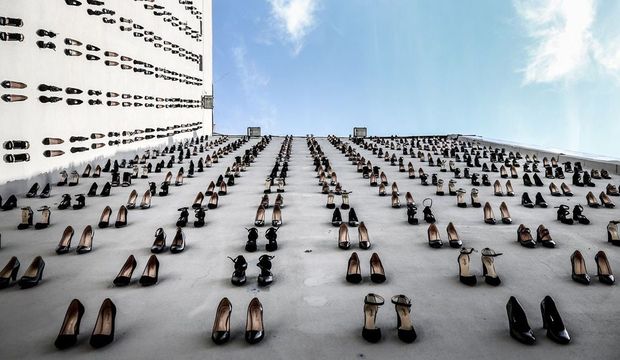They say that there is a tradition going on for a long time in Anatolia; placing the dead person’s shoes in front of the door, pointing outside. To some, this tradition is practised to keep away death from the house while, to others, it is conducted to make the others know that someone died in the family.
The photo above was designed by the artist Vahit Tuna, referring to this tradition in 2018. Each pair of shoes symbolizes 440 women losing their lives in male violence in that year.
Instead of saying 440 women losing their lives, I would like to say FOUR HUNDRED AND FORTY WOMEN who died.
We are approaching another March 8th when many commemorate these dead women just with figures. I believe that although figures are necessary means to reflect the severity of the event, in cases where we don’t/can’t pass beyond the figures, they don’t serve any other purpose except desensitizing our hearts.
Imagine you are at the bottom of the wall. You need to raise your head or move away from the wall to see all the shoes, don’t you? They are so many. Now imagine a woman in each pair; even choose these women among the ones you know.If the number of women in your family or friends is not as many, add the ones you know little or you have met on an occasion only. Think that 440 women you know are looking at you fixed from their shoes on that wall... Has it a little helped the truth progress from your brains to your hearts?
You see the area your hearts touched is the grief itself even if your contact lasted a minute. This is the place where you step in with your heart’s becoming a witness of your human brothers’ losses in addition to your own personal losses and its feeling the pain in the society’s collective grief area as if it were its own pain. This is also the place which called Vahit Tuna to express his grief.
Grief needs to slow down and to be seen. Without slowing down, it is not possible to feel-see the number 440, four hundred and forty dead women, with all its severity.And after seeing this, it is also possible for you to experience the difficulty of carrying all this weight in you on your own. The reason for the existence of grief rituals is this, after all.
Grief rituals help us carry the emptiness created by the absence of those four hundred and forty women though it hurts and transform our feelings which cannot find a place to go, our longings, angers, rebellions, sorrows into a state to feed us without poisoning us.
Getting together for collective griefs,lighting candles, wearing black, carrying ribbons on us, wailing, singing songs, expressing our sorrow in a picture, movement or any branch of art. Above all, hugging and crying… Do you see that if we don’t do these, we will die going crazy?
Let’s leave ourselves to the wild arms of grief instead of going crazy. Let’s get wild with the tones of the jarring sound of wailing, the tears we think will take out our hearts or the brushes we give our hands to. Rather than falling pray to the dry, cold and expressionless states of figures and the mindset they represent, let’s live shedding four hundred and forty tears for each of the women.
There is nothing like recovering from grief but there is something like grief healing us.
May my tears be for each woman who has touched life with their lives. As Martin Prechtel says in his book The Smell of Rain on Dust, may our souls not dry thanks to the tears we can shed.
Yazının Türkçe versiyonu: Ölen dört yüz kırk kadın





YORUMLAR